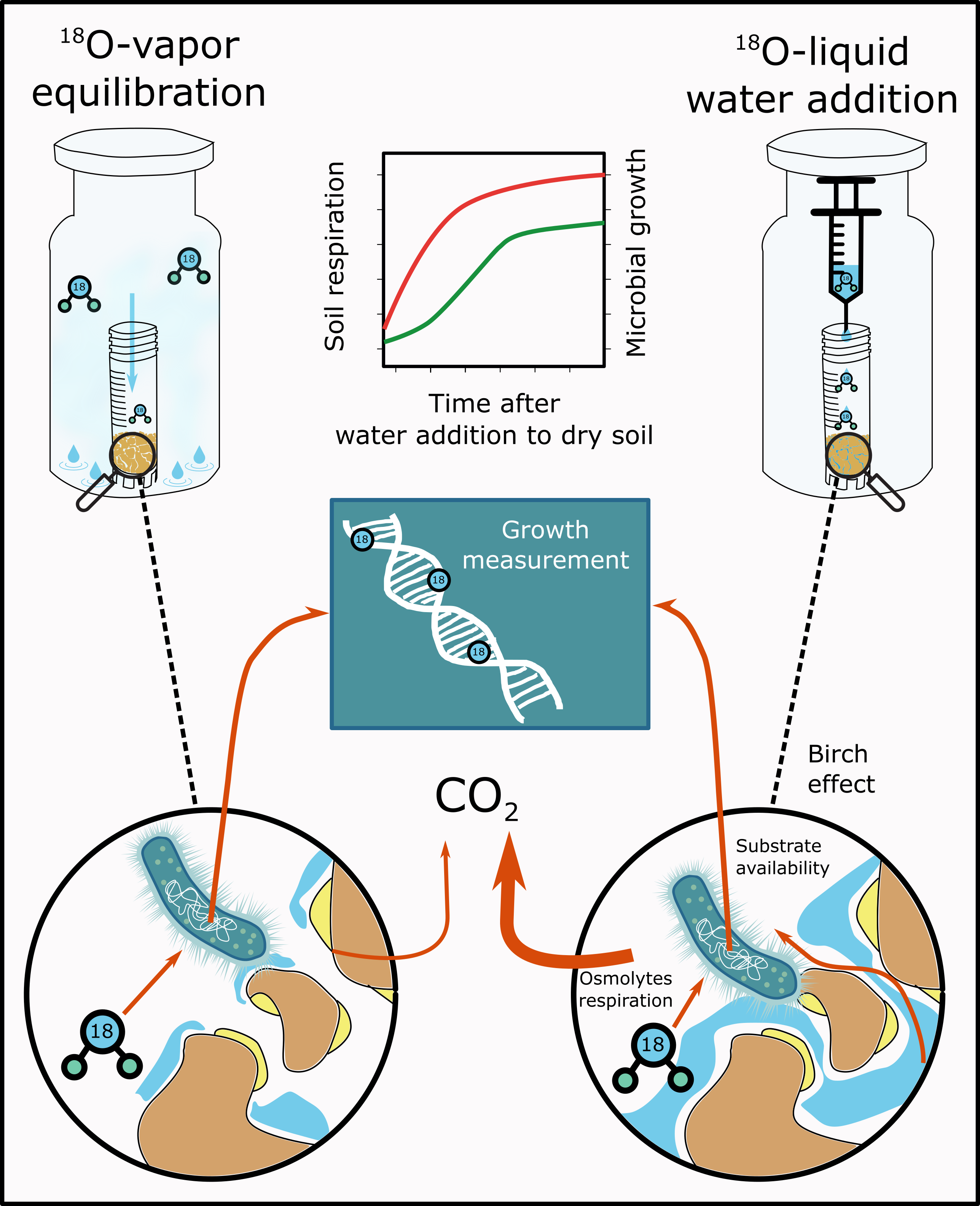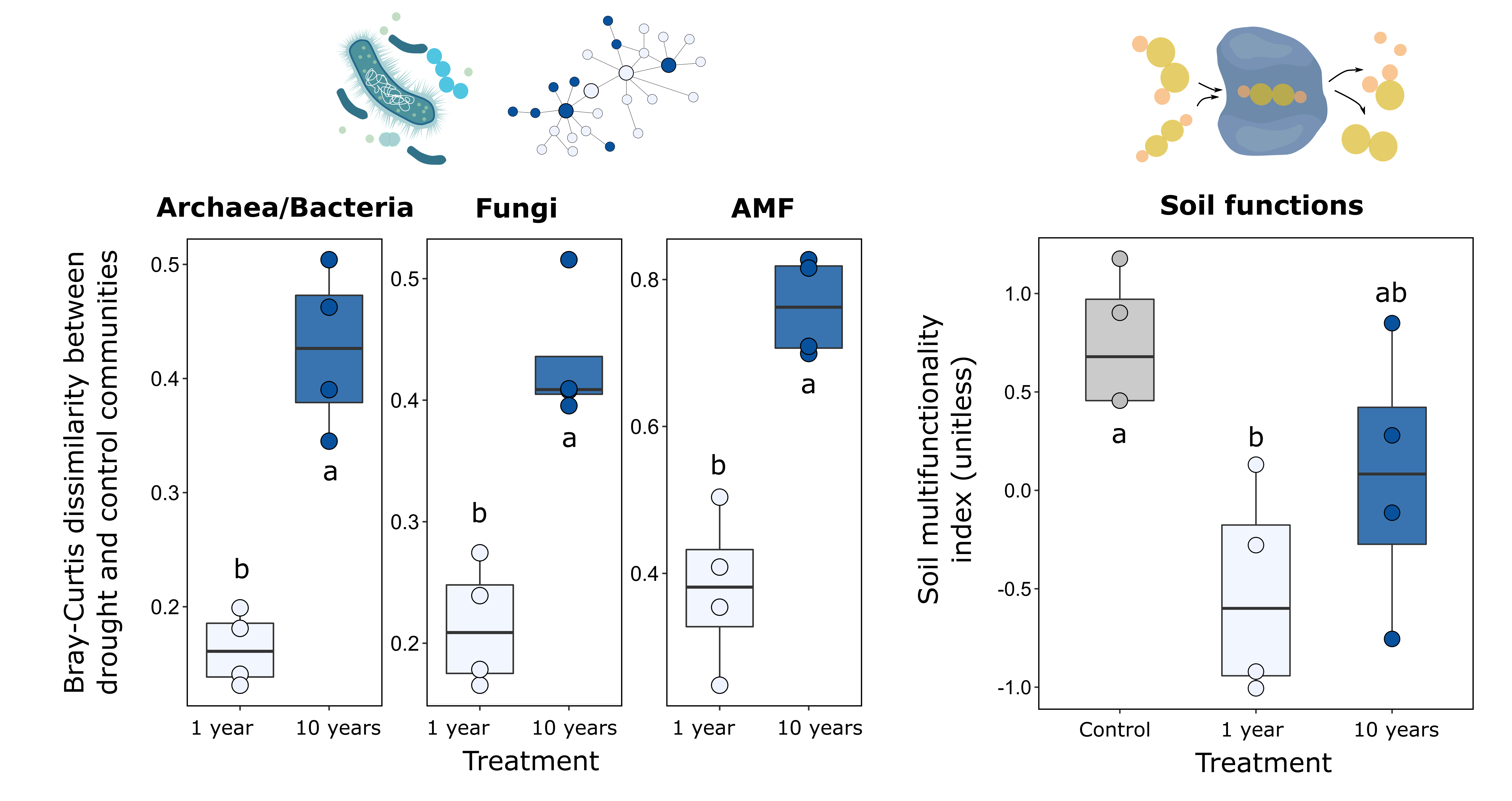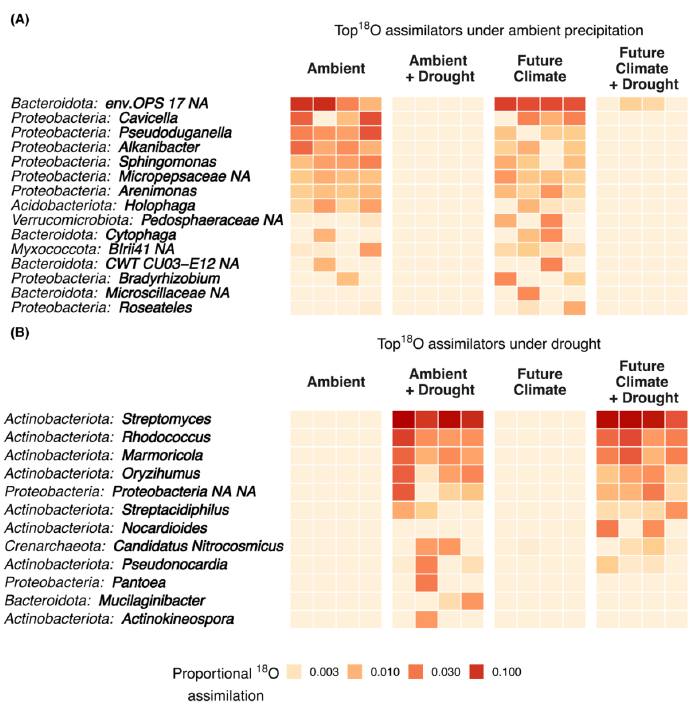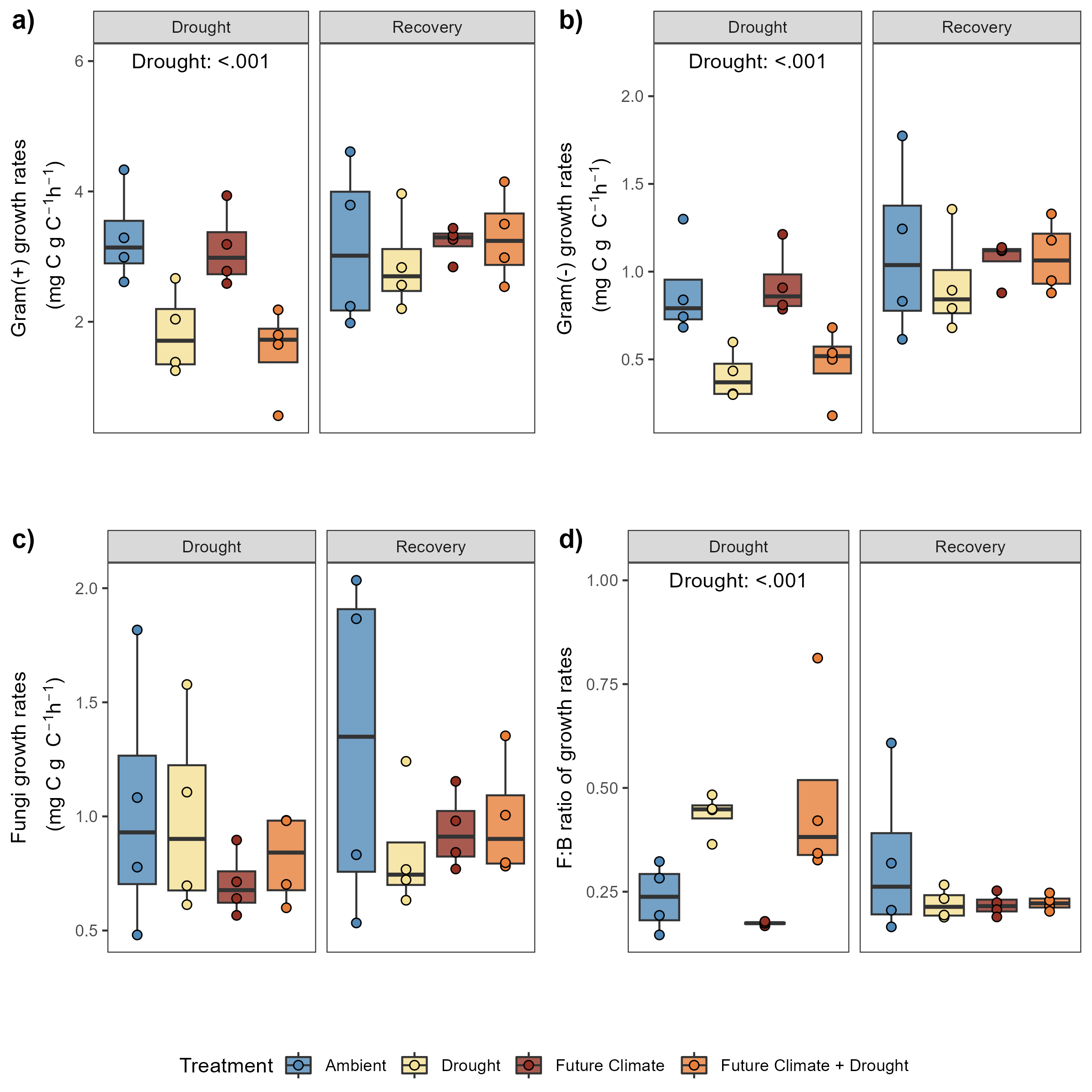Publications
For a full list see below or go to Google Scholar , ResearcherID
Highlights
Quantifying microbial growth and carbon use efficiency in dry soil environments via 18O water vapor equilibration

We developed a unique method that allows for the first time to introduce stable isotope in soil without direct water addition. This has generated enourmous developments for measuring microbial growth in soil, from application to drought studies to intact soil cores, from community level measurements to taxa specific growth rates.
Canarini A., Wanek W., Watzka M., Sandén T., Spiegel H., Šantrůček J. and Schnecker J.
Global Change Biology 26(9), 5333–5341 (2020)
Ecological memory of recurrent drought modifies soil processes via changes in soil microbial community

We discovered that soil microbial community composition changes in concert with its functioning, with consequences for soil processes. The formation of ecological memory in soil under recurrent drought may enhance the resilience of ecosystem functioning against future drought events.
Canarini A., Schmidt H., Fuchslueger L., Martin V., Herbold C. W., Zezula D., Gündler P., Hasibeder R., Jecmenica M., Bahn M., and Richter A.
Nature Communications, 12(1), 5308 (2021)
Microbial growth under drought is confined to distinct taxa and modified by potential future climate conditions

We applied the vapor equilibration method in combination with the qSIP to obtain taxa-specific growth rates. We found that during drought fewer taxa grow but they sustain high growth rates, and that future climate conditions (higher temperatures and atmospheric CO2) modified these taxa.
Metze D., Schnecker J., Canarini A., Fuchslueger L., Koch B. J., Stone B. W., Hungate B. A., Hausmann B., Schmidt H., Schaumberger A., Bahn M., Kaiser C., and Richter A.
Nature Communications, 14(1), 1–12 (2023)
Soil fungi remain active and invest in storage compounds during drought independent of future climate conditions

We trace 2H or 18O applied via water-vapor exchange into membrane (and storage) fatty acids or DNA, respectively, to assess community- and group-level adjustments in soil microbial physiology (replication, storage product synthesis, and carbon use efficiency). We show that, while bacterial growth decreases by half during drought, fungal growth remains stable, demonstrating a remarkable resistance against soil moisture changes. In addition, fungal investment into storage triglycerides increases more than five-fold under drought.
Canarini A., Fuchslueger L., Schnecker J., Metze D., Nelson D., Kahmen A., Watzka M., Pötsch E., Schaumberger A., Bahn M. and Richter A.
Nature Communications, 15, 10410 (2024)
Preprints
-
Canarini, A., Fuchslueger, L., Schnecker, J., Metze, D., Nelson, D., Kahmen, A., Watzka, M., Poetsch, E. M., Schaumberger, A., Bahn, M., & Richter, A. (2023). Soil fungi remain active and invest in storage compounds during drought independent of future climate conditions. bioRxiv; Pages: 2023.10.23.563577 Section: New Results. https://www.biorxiv.org/content/10.1101/2023.10.23.563577v1
Refereed journal articles
2025
-
Gorka, S., Canarini, A., Schmidt, H., & Kaiser, C. (2025). Soil bacterial neutral lipid fatty acids: Markers for carbon storage or necromass? Soil Biology and Biochemistry, 208, 109855. https://www.sciencedirect.com/science/article/pii/S0038071725001488
-
Schärer, M.-L., Fuchslueger, L., Canarini, A., Richter, A., Lüscher, A., & Kahmen, A. (2025). Post-drought organic carbon mineralization leads to high productivity and nutrient uptake efficiency of perennial grassland after rewetting. Soil Biology and Biochemistry, 204, 109744. https://www.sciencedirect.com/science/article/pii/S0038071725000367
-
Leyrer, V., Blum, J., Marhan, S., Kandeler, E., Zimmermann, T., Berauer, B. J., Schweiger, A. H., Canarini, A., Richter, A., & Poll, C. (2025). Drought Impacts on Plant–Soil Carbon Allocation—Integrating Future Mean Climatic Conditions. Global Change Biology, 31(2), e70070. _eprint: https://onlinelibrary.wiley.com/doi/pdf/10.1111/gcb.70070. https://onlinelibrary.wiley.com/doi/abs/10.1111/gcb.70070
2024
-
Canarini, A., Fuchslueger, L., Schnecker, J., Metze, D., Nelson, D. B., Kahmen, A., Watzka, M., Pötsch, E. M., Schaumberger, A., Bahn, M., & Richter, A. (2024). Soil fungi remain active and invest in storage compounds during drought independent of future climate conditions. Nature Communications, 15(1), 10410. Publisher: Nature Publishing Group. https://www.nature.com/articles/s41467-024-54537-y
-
Martin, V., Schmidt, H., Canarini, A., Koranda, M., Hausmann, B., Müller, C. W., & Richter, A. (2024). Soil cover shapes organic matter pools and microbial communities in soils of maritime Antarctica. Geoderma, 446, 116894. https://www.sciencedirect.com/science/article/pii/S001670612400123X
-
Yang, L., Canarini, A., Zhang, W., Lang, M., Chen, Y., Cui, Z., Kuzyakov, Y., Richter, A., Chen, X., Zhang, F., & Tian, J. (2024). Microbial life-history strategies mediate microbial carbon pump efficacy in response to N management depending on stoichiometry of microbial demand. Global Change Biology, 30(5), e17311. _eprint: https://onlinelibrary.wiley.com/doi/pdf/10.1111/gcb.17311. https://onlinelibrary.wiley.com/doi/abs/10.1111/gcb.17311
2023
-
Gorka, S., Darcy, S., Horak, J., Imai, B., Mohrlok, M., Salas, E., Richter, A., Schmidt, H., Wanek, W., Kaiser, C., & Canarini, A. (2023). Beyond PLFA: Concurrent extraction of neutral and glycolipid fatty acids provides new insights into soil microbial communities. Soil Biology and Biochemistry, 187, 109205. https://www.sciencedirect.com/science/article/pii/S0038071723002675
-
Metze, D., Schnecker, J., Canarini, A., Fuchslueger, L., Koch, B. J., Stone, B. W., Hungate, B. A., Hausmann, B., Schmidt, H., Schaumberger, A., Bahn, M., Kaiser, C., & Richter, A. (2023). Microbial growth under drought is confined to distinct taxa and modified by potential future climate conditions. Nature Communications, 14(1), 1–12. Number: 1 Publisher: Nature Publishing Group. https://www.nature.com/articles/s41467-023-41524-y
-
Fujita, H., Ushio, M., Suzuki, K., Abe, M. S., Yamamichi, M., Iwayama, K., Canarini, A., Hayashi, I., Fukushima, K., Fukuda, S., Kiers, E. T., & Toju, H. (2023). Alternative stable states, nonlinear behavior, and predictability of microbiome dynamics. Microbiome, 11(1), 63. https://doi.org/10.1186/s40168-023-01474-5
-
Zheng, J., Canarini, A., Fujii, K., Mmari, W. N., Kilasara, M. M., & Funakawa, S. (2023). Cropland intensification mediates the radiative balance of greenhouse gas emissions and soil carbon sequestration in maize systems of sub-Saharan Africa. Global Change Biology, 29(6), 1514–1529. Publisher: John Wiley & Sons, Ltd. https://doi.org/10.1111/gcb.16550
-
Zheng, J., Fujii, K., Koba, K., Wanek, W., Müller, C., Jansen-Willems, A. B., Nakajima, Y., Wagai, R., & Canarini, A. (2023). Revisiting process-based simulations of soil nitrite dynamics: Tighter cycling between nitrite and nitrate than considered previously. Soil Biology and Biochemistry, 178, 108958. https://www.sciencedirect.com/science/article/pii/S0038071723000202
-
Fujita, H., Ushio, M., Suzuki, K., Abe, M. S., Yamamichi, M., Okazaki, Y., Canarini, A., Hayashi, I., Fukushima, K., Fukuda, S., Kiers, E. T., & Toju, H. (2023). Metagenomic analysis of ecological niche overlap and community collapse in microbiome dynamics. Frontiers in Microbiology, 14. https://www.frontiersin.org/articles/10.3389/fmicb.2023.1261137
-
Fujita, H., Ushio, M., Suzuki, K., Abe, M. S., Yamamichi, M., Okazaki, Y., Canarini, A., Hayashi, I., Fukushima, K., Fukuda, S., Kiers, E. T., & Toju, H. (2023). Facilitative interaction networks in experimental microbial community dynamics. Frontiers in Microbiology, 14. https://www.frontiersin.org/articles/10.3389/fmicb.2023.1153952
2022
-
Verbrigghe, N., Meeran, K., Bahn, M., Canarini, A., Fransen, E., Fuchslueger, L., Ingrisch, J., Janssens, I. A., Richter, A., Sigurdsson, B. D., Soong, J. L., & Vicca, S. (2022). Long-term warming reduced microbial biomass but increased recent plant-derived C in microbes of a subarctic grassland. Soil Biology and Biochemistry, 167, 108590. https://www.sciencedirect.com/science/article/pii/S0038071722000475
-
Gavazov, K., Canarini, A., Jassey, V. E. J., Mills, R., Richter, A., Sundqvist, M. K., Väisänen, M., Walker, T. W. N., Wardle, D. A., & Dorrepaal, E. (2022). Plant-microbial linkages underpin carbon sequestration in contrasting mountain tundra vegetation types. Soil Biology and Biochemistry, 165, 108530. https://www.sciencedirect.com/science/article/pii/S0038071721004041
-
Maxwell, T. L., Canarini, A., Bogdanovic, I., Böckle, T., Martin, V., Noll, L., Prommer, J., Séneca, J., Simon, E., Piepho, H.-P., Herndl, M., Pötsch, E. M., Kaiser, C., Richter, A., Bahn, M., & Wanek, W. (2022). Contrasting drivers of belowground nitrogen cycling in a montane grassland exposed to a multifactorial global change experiment with elevated CO2, warming, and drought. Global Change Biology, 28(7), 2425–2441. _eprint: https://onlinelibrary.wiley.com/doi/pdf/10.1111/gcb.16035. https://onlinelibrary.wiley.com/doi/abs/10.1111/gcb.16035
2021
-
Canarini, A., Schmidt, H., Fuchslueger, L., Martin, V., Herbold, C. W., Zezula, D., Gündler, P., Hasibeder, R., Jecmenica, M., Bahn, M., & Richter, A. (2021). Ecological memory of recurrent drought modifies soil processes via changes in soil microbial community. Nature Communications, 12(1), 5308. Number: 1 Publisher: Nature Publishing Group. https://www.nature.com/articles/s41467-021-25675-4
-
Alteio, L. V., Séneca, J., Canarini, A., Angel, R., Jansa, J., Guseva, K., Kaiser, C., Richter, A., & Schmidt, H. (2021). A critical perspective on interpreting amplicon sequencing data in soil ecological research. Soil Biology and Biochemistry, 160, 108357. https://www.sciencedirect.com/science/article/pii/S0038071721002303
-
Meeran, K., Ingrisch, J., Reinthaler, D., Canarini, A., Müller, L., Pötsch, E. M., Richter, A., Wanek, W., & Bahn, M. (2021). Warming and elevated CO2 intensify drought and recovery responses of grassland carbon allocation to soil respiration. Global Change Biology, 27(14), 3230–3243. _eprint: https://onlinelibrary.wiley.com/doi/pdf/10.1111/gcb.15628. https://onlinelibrary.wiley.com/doi/abs/10.1111/gcb.15628
2020
-
Séneca, J., Pjevac, P., Canarini, A., Herbold, C. W., Zioutis, C., Dietrich, M., Simon, E., Prommer, J., Bahn, M., Pötsch, E. M., Wagner, M., Wanek, W., & Richter, A. (2020). Composition and activity of nitrifier communities in soil are unresponsive to elevated temperature and CO2, but strongly affected by drought. The ISME Journal, 14(12), 3038–3053. Number: 12 Publisher: Nature Publishing Group. https://www.nature.com/articles/s41396-020-00735-7
-
Simon, E., Canarini, A., Martin, V., Séneca, J., Böckle, T., Reinthaler, D., Pötsch, E. M., Piepho, H.-P., Bahn, M., Wanek, W., & Richter, A. (2020). Microbial growth and carbon use efficiency show seasonal responses in a multifactorial climate change experiment. Communications Biology, 3(1), 1–10. Number: 1 Publisher: Nature Publishing Group. https://www.nature.com/articles/s42003-020-01317-1
-
Canarini, A., Wanek, W., Watzka, M., Sandén, T., Spiegel, H., Šantrůček, J., & Schnecker, J. (2020). Quantifying microbial growth and carbon use efficiency in dry soil environments via 18O water vapor equilibration. Global Change Biology, 26(9), 5333–5341. _eprint: https://onlinelibrary.wiley.com/doi/pdf/10.1111/gcb.15168. https://onlinelibrary.wiley.com/doi/abs/10.1111/gcb.15168
2019
-
Canarini, A., Kaiser, C., Merchant, A., Richter, A., & Wanek, W. (2019). Root Exudation of Primary Metabolites: Mechanisms and Their Roles in Plant Responses to Environmental Stimuli. Frontiers in Plant Science, 10. https://www.frontiersin.org/articles/10.3389/fpls.2019.00157
2018
-
Canarini, A., Mariotte, P., Ingram, L., Merchant, A., & Dijkstra, F. A. (2018). Mineral-Associated Soil Carbon is Resistant to Drought but Sensitive to Legumes and Microbial Biomass in an Australian Grassland. Ecosystems, 21(2), 349–359. https://doi.org/10.1007/s10021-017-0152-x
2017
-
Canarini, A., Kiær, L. P., & Dijkstra, F. A. (2017). Soil carbon loss regulated by drought intensity and available substrate: A meta-analysis. Soil Biology and Biochemistry, 112, 90–99. https://www.sciencedirect.com/science/article/pii/S0038071716306198
-
Carrillo, Y., Bell, C., Koyama, A., Canarini, A., Boot, C. M., Wallenstein, M., & Pendall, E. (2017). Plant traits, stoichiometry and microbes as drivers of decomposition in the rhizosphere in a temperate grassland. Journal of Ecology, 105(6), 1750–1765. _eprint: https://besjournals.onlinelibrary.wiley.com/doi/pdf/10.1111/1365-2745.12772. https://onlinelibrary.wiley.com/doi/abs/10.1111/1365-2745.12772
-
Mariotte, P., Canarini, A., & Dijkstra, F. A. (2017). Stoichiometric N:P flexibility and mycorrhizal symbiosis favour plant resistance against drought. Journal of Ecology, 105(4), 958–967. _eprint: https://onlinelibrary.wiley.com/doi/pdf/10.1111/1365-2745.12731. https://onlinelibrary.wiley.com/doi/abs/10.1111/1365-2745.12731
2016
-
Canarini, A., Merchant, A., & Dijkstra, F. A. (2016). Drought effects on Helianthus annuus and Glycine max metabolites: from phloem to root exudates. Rhizosphere, 2, 85–97. https://www.sciencedirect.com/science/article/pii/S2452219816300647
-
Canarini, A., Carrillo, Y., Mariotte, P., Ingram, L., & Dijkstra, F. A. (2016). Soil microbial community resistance to drought and links to C stabilization in an Australian grassland. Soil Biology and Biochemistry, 103, 171–180. https://www.sciencedirect.com/science/article/pii/S0038071716302097
-
Dijkstra, F. A., Carrillo, Y., Aspinwall, M. J., Maier, C., Canarini, A., Tahaei, H., Choat, B., & Tissue, D. T. (2016). Water, nitrogen and phosphorus use efficiencies of four tree species in response to variable water and nutrient supply. Plant and Soil, 406(1), 187–199. https://doi.org/10.1007/s11104-016-2873-6
2015
-
Canarini, A., & Dijkstra, F. A. (2015). Dry-rewetting cycles regulate wheat carbon rhizodeposition, stabilization and nitrogen cycling. Soil Biology and Biochemistry, 81, 195–203. https://www.sciencedirect.com/science/article/pii/S0038071714004003
2010
-
Salvucci, M. E., Barta, C., Byers, J. A., & Canarini, A. (2010). Photosynthesis and assimilate partitioning between carbohydrates and isoprenoid products in vegetatively active and dormant guayule: physiological and environmental constraints on rubber accumulation in a semiarid shrub. Physiologia Plantarum, 140(4), 368–379. _eprint: https://onlinelibrary.wiley.com/doi/pdf/10.1111/j.1399-3054.2010.01409.x. https://onlinelibrary.wiley.com/doi/abs/10.1111/j.1399-3054.2010.01409.x
Book Chapters and Editorials
-
Fuchslueger, L., Solly, E. F., Canarini, A., & Brangarí, A. C. (2024). Overview: Global change effects on terrestrial biogeochemistry at the plant–soil interface. In Biogeosciences (Vol. 21, Number 17, pp. 3959–3964). Publisher: Copernicus GmbH. https://bg.copernicus.org/articles/21/3959/2024/
-
Canarini, A., Fuchslueger, L., Joly, F.-X., & Richter, A. (2023). Climate change impacts on soil biology. In M. J. Goss & M. Oliver (Eds.), Encyclopedia of Soils in the Environment (Second Edition) (pp. 578–586). Academic Press. https://www.sciencedirect.com/science/article/pii/B9780128229743002445
-
Preece, C., Canarini, A., Verbruggen, E., & Fuchslueger, L. (2021). Editorial: Exchanges at the Root-Soil Interface: Resource Trading in the Rhizosphere That Drives Ecosystem Functioning. In Frontiers in Forests and Global Change (Vol. 4). https://www.frontiersin.org/articles/10.3389/ffgc.2021.747492